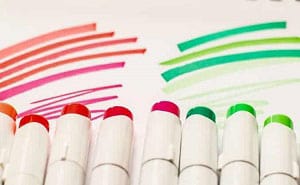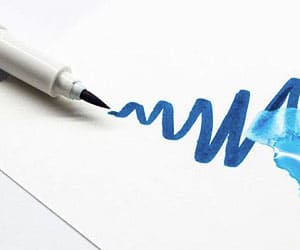The two most popular types of markers for artists, illustrators, and students are alcohol-based and water-based. These are even more popular and useful for both office and home use.
If we are to compare alcohol vs water based markers, the categories will be quite competitive. This is the reason why making a decision between the two can be challenging and necessitates a thorough understanding of their similarities, differences, and features.
In this article, we will go through an in-depth water-based and alcohol markers comparison guide to break down their unique traits, features, and advantages.
Table of Contents
What is the Difference Between an Alcohol Marker and a Water-Based Marker?
1. Alcohol-based Markers
Alcohol-based markers are made of an alcohol-based ink that is more resistant to smudging and fading. They are also referred to as solvent-based markers or blended fiber markers.
These markers are renowned for their vivid hues or colors, high saturation levels, being waterproof, and capacity to blend seamlessly with other hues.
2. Water-based Markers
Water-based markers are made of water-based ink that has been blended with a dye. They are popularly known for their transparency and ability to produce a variety of colors.
Additionally, water-based markers blend well when used with other water-based markers, producing watercolor effects. Thus, they are also referred to as “watercolor markers”.
A Quick Overview
| FEATURES | Alcohol-based Markers | Water-based Markers |
| Ink Type | Dye-based alcohol ink; waterproof | Water-based ink; water-soluble |
| Color Intensity and Quality | Vibrant and highly pigmented color | Soft tones; less vibrant |
| Blending Capabilities | Highly blendable | Does not blend well; usually leaves uneven and streaky appearance |
| Durability and Longevity | Permanent; resistant to fade, smudge, and smears; difficult to edit | Not permanent; can be permanent on porous surfaces; can easily be washed off to correct mistakes |
| Drying Time | Fast-drying | Slow drying time |
| Safety | Strong odor; may cause irritation or allergies | Odorless and non-toxic |
| Skill Level | Ideal for professional and experienced artists | Ideal for beginner artists |
| Clean-up | Hard to remove | Easy to clean up |
| Paper Bleed | May bleed through paper, especially when used on thin paper | Resistant to bleeding but may cause warping when used on a wrong paper type |
| Price | Typically expensive | Affordable |
Breakdown of Features
Let us go through several criteria in detail for an in-depth review of alcohol based markers vs water based markers.
- Ink Type
Sifting through the primary difference of water based markers vs alcohol markers, it goes down to the type of ink used.
Alcohol markers make use of a type of ink known as dye-based alcohol ink, which is composed of dyes, solvents, and resins. This ink is highly pigmented and produces bright, vibrant colors, resisting fading and smudging.
In contrast, water-based markers use water-based ink. Because the ink is less pigmented than alcohol-based ink, the colors are less vibrant and more subdued.
Moreover, water-based markers are water-soluble. This means that the ink can be reactivated with water for reworking even after it has already dried.
- Color Intensity and Quality
The intensity of the colors is one of the most noticeable differences between these types of markers.
Alcohol markers used for graphic designs yield a more vivid appearance. They are popular for their vibrant colors that are highly pigmented and fade-resistant.
This is why alcohol based brush tip markers are so useful for projects that require controlled color intensity.
With regards to water-based markers, they have more subdued and less intense colors than alcohol-based markers. Depending on the type of project, this can be both an advantage and a disadvantage.
- Blending Capabilities and Paper Bleed
Another significant distinction between alcohol-based markers and water-based markers is their ability to blend with other colors.
Alcohol-based markers are highly blendable, resulting in smooth gradations and seamless color blends. No doubt many artists use alcohol markers for blending and layering tones.
Meanwhile, water-based markers are quite the contrary. Since they stay on top of the surface, the colors do not usually blend well, leaving a streaky and uneven finish.
However, these markers are still incredibly versatile and can work well on most surfaces since alcohol based markers bleed through paper. But make sure to use them on watercolor paper or any compatible paper to prevent warping.
- Durability and Longevity
The high resistance to fading, smudging, and water make these alcohol markers permanent. Therefore, these markers are ideal for art projects that will be displayed or stored for an extended period of time.
Water-based markers fade and smudge more easily over time. Not to mention that it can be affected by water. For that reason, this characteristic makes water based markers washable. They produce delicate artwork that may not be as durable as alcohol-based marker art.
- Drying Time
Alcohol-based markers are quick-drying, allowing you to produce multiple color layers and blends. Water-based markers require more time to dry.
- Safety
Alcohol-based markers tend to have strong odor and can be toxic, which may not be completely safe for children to use or those with allergies. Unless they are used in a well-ventilated area, it may result in allergies, dizziness, or irritation.
Meanwhile, water-based markers are odorless and non-toxic, making them a much safer option for beginners, children, and young students.
- Skill Level
Alcohol-based markers are typically suitable for experienced and professional artists because of their quality and performance. Copic and Ohuhu alcohol markers are some examples.
On the other hand, water-based markers have more appeal to beginners since they are versatile and can be reworked smoothly.
- Price
Water-based markers have more affordable options than alcohol-based markers.
Frequently Asked Questions
Can alcohol-based markers be used on watercolor paper?
Yes, alcohol-based markers can be used on watercolor paper, but the results may not be ideal. Watercolor paper is designed to absorb water-based pigments.
When used with alcohol-based markers, the ink may not adhere effectively. It may also appear duller or less vibrant if used on a smoother surface.
However, it is possible to achieve some level of blending using them, but it can be more challenging. It is recommended to test the markers on a small area of the paper before drawing on a larger piece.
Is it possible to blend colors with water-based markers?
Yes, water-based markers blend nicely when utilized carefully. The blending process is similar to traditional watercolor painting where colors are layered and blended together to create new hues.
On the other hand, if you mix alcohol and water based markers, this may not work well. Water-based markers have water-soluble ink, which can be reactivated by adding water to the tip of the marker. When colors are layered, they blend together and create a more seamless transition.
How do I clean up after using alcohol-based markers?
It is recommended to use an alcohol-based cleaner, such as rubbing alcohol, to remove the ink from surfaces and tools. You can also use a solvent-based cleaner like mineral spirits.
Make sure to be very careful with these products since they are flammable and toxic. Use them in a well-ventilated area and follow safety precautions at all times.
If you get alcohol-based markers on your skin, washing with soap and water will do. Apply some makeup remover or rubbing alcohol to remove any ink residues.
What are the main differences between Ohuhu water-based markers and alcohol-based markers?
If we talk about Ohuhu water based vs alcohol based markers, the significant difference is the ink type and the way it is utilized. Ohuhu markers use odorless and washable water-based ink.
However, since they easily wash off with water, it may be difficult to make these water-based markers permanent. Nonetheless, they can be blended easily for subtle gradation effects.
Typical alcohol-based markers use ink that is based on solvents, which are strongly odorous, toxic, and hard to clean up with water. They are quick-drying, permanent, and resistant to smudges and smear.
Conclusion
Ultimately, the choice between alcohol vs water based markers will not be as difficult as it seems. Although it may depend on the specific needs and preferences of the artist or designer, both types of markers have their own unique set of pros and cons for consideration.
It is always a good idea to test out both types of markers before going to a larger or full-scale artwork. The information discussed in this article will help you choose the best markers for your future projects.

Art has always been a part of my life; it influences my upbringing and later my career choice. For me, it is always a part of my parenting technique. So for whichever purpose that you come to art, you can start here with us.




